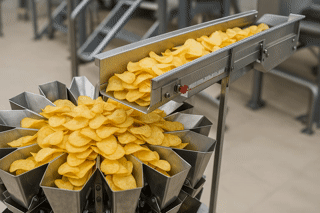We’ve often talked about how a बहु-सिर वाला तौलने वाला is the heart of a modern packaging line. Its accuracy directly impacts your costs, product quality, and overall efficiency.
But let’s be honest—knowing “accuracy matters” and actually achieving high accuracy are two very different things. Crossing that gap requires both solid technology and meticulous daily management.
Today, let’s break down the critical steps you can take to fine-tune your weighing system and consistently hit that sweet spot of precision.

⚙️ 1. The Foundation of Material Flow: Optimizing Feeding and Distribution
✅ Fine-Tuning the Linear Vibrators
- Amplitude and Frequency:
This is the key to controlling how fast and evenly materials flow onto the main feeder pan. Too strong, and materials splash, pile up, or even break. Too weak, and the supply slows down, hurting productivity. - 🎯 Pro Tip: For delicate products like potato chips or puffed snacks, low amplitude with high frequency often works best.
- Vibration Direction and Angle:
Make sure the vibration is smooth and consistent so materials flow evenly into the main feeder pan without drifting to one side. Regularly check for any looseness or misalignment in the vibrators. - Keep It Clean:
Leftover materials or grease on the feeder tray can significantly change friction, disrupting flow. Daily cleaning is non-negotiable.
✅ Mastering the Main Feeder Pan
- Surface Condition:
Keep it absolutely clean, dry, and smooth. Even minor scratches or residue can disrupt material flow. - Vibration Patterns:
Modern बहु-सिर वाले तौलने वाले offer multiple vibration modes (e.g., strong-to-weak or stepwise). Test and select the pattern that ensures materials move in a single layer and flow gently into the distribution system. - Adjusting the Baffle Plates:
Set the exit baffles just right so material flows steadily into the distributors without overloading.
🎯 2. Precision Distribution: Guiding Material Into the Weighing Buckets
✅ Optimizing the Distributors
- Design Fit:
The distributor’s shape, angle, and finish must match the product. For sticky items like dried fruit, consider steeper angles and non-stick coatings. - Positioning:
Ensure the distributor outlet aligns perfectly with the center of the weighing bucket to avoid product bouncing off the sides.
✅ Keeping Weigh Buckets “Pure”
- Extreme Cleanliness:
Any leftover particles—no matter how small—can throw off the tare weight. Using auto zero tracking helps maintain accuracy, but thorough manual cleaning is still critical. - Structural Integrity:
Regularly inspect for bent buckets, loose springs, or damaged hinges. Even minor issues can lead to product sticking or inconsistent readings. - Control Moisture and Static:
A dry, static-free environment helps materials flow freely and prevents clinging. Anti-static tools or ionizing air blowers are great allies.
📏 3. The Judge of Accuracy: Load Cells and Weighing Electronics
✅ Protecting and Calibrating Sensors
- Routine Calibration:
This is the lifeline for accuracy. Use certified test weights and follow manufacturer instructions closely. If your production area experiences frequent temperature or humidity changes, increase calibration frequency. - Shield From External Interference:
Position the बहु-सिर वाला तौलने वाला away from strong airflows or nearby vibrating equipment. - Avoid Overloading:
Never exceed the rated weight, and protect sensors from accidental impacts during cleaning or refilling.
🧠 4. Smart Algorithms and Compensation Functions
- Target Weight Setting:
Set the target slightly above the nominal weight (e.g., 100.5g for a 100g pack) to allow the system room for combination optimization. - Combination Strategies:
Select the strategy that best fits your product and packaging—whether it’s standard combination, target priority, or count priority. - Compensation Features:
Use average weight feedback control to automatically adjust for gradual shifts in product characteristics like moisture content.
🔧 5. The Human Factor: Operations and Preventive Maintenance
✅ Train Your Operators
Operators should understand why precision matters and be skilled at cleaning, basic inspections, material changeovers, and minor parameter adjustments like vibration amplitude.
✅ Build a Preventive Maintenance Plan
- Daily: Clean thoroughly, especially corners and hinges.
- Weekly: Check sensor connections, vibrators, and air pressure.
- Monthly: Perform calibration and detailed inspections.
- Annually: Deep maintenance, including lubrication and full electrical checks.
✅ Spare Parts Management
Keep critical spares like drive boards, sensors, and vibratory motors in stock to minimize downtime during repairs.
🥇 The Secret Ingredient: Know Your Material
Every product is different:
- Flowability: Does it move like water or stick like clay?
- Uniformity: Are pieces consistent in size and shape?
- Fragility: Will it crumble under vibration?
- Moisture/Oil Content: Prone to clumping or sticking?
Understanding your product fully is the first step in selecting the right machine configuration and fine-tuning it for peak performance.
🚀 Precision Is a System, Not a Shortcut
Boosting बहु-सिर वाला तौलने वाला accuracy isn’t about a single magic adjustment—it’s about systematic attention to detail.
- Optimize feeding and distribution.
- Keep weigh buckets pristine and perfectly aligned.
- Care for your sensors like gold.
- Use algorithms and compensation tools smartly.
- Train your team and maintain proactively.
💡 Remember: In the pursuit of precision, details make all the difference. Done right, you’ll cut waste, improve pack consistency, and delight your customers—all while reducing costs.
📣 Want Smarter Weighing Solutions?
पर पैकेज भरें, हम डिजाइन करते हैं खाद्य पैकेजिंग मशीनें और multihead weighing systems that make precision effortless. From sticky gummies to delicate potato chips, we’ll help you configure the perfect setup.
✅ Contact us today to learn how we can fine-tune your production line for accuracy, efficiency, and peace of mind.

